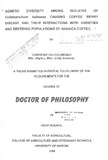| dc.description.abstract | The objective of this study was to determine the nature and magnitude of
genetic diversity of Colletotrichum kahawae Waller & Bridge (1993), the causal
agent of coffee berry disease (CBD) and its implication on pathogen adaptation to
resistant host varieties. Single conidia isolates of C. kahawae were subjected to
genetic analysis using virulence tests, protein, isozyme and Random Amplified
Polymorphic DNA (RAPD) markers. Two Benomyl tolerant strains and two nonpathogenic
species, C. acutatum and C. gloeosporioides commonly found colonising
the coffee plant were included in the analyses for comparison. Virulence tests
revealed that a large proportion of the variation (64.81 %) was due to main effects of
varieties and isolates usually associated with differences in aggressiveness. The
.variety x isolate interaction effects, although significant (p ~ 0.01) was too small
(14.60%) to suggest conclusively that races exists.
Buffer soluble proteins separated on a 10% polyacrylamide gel and stained
with silver nitrate easily detected variation between Colletotrichum species in the
region of 173 kDa, 45 kDa and 40 kDa. Small differences were also detected among
isolates of C. kahawae with proteins of molecular weights of 123 kDa and 52 kDa but
were neither diagnostic for virulence nor Benomyl tolerance.
A total of 12 enzyme systems were assayed and 28 putative loci detected.
Isolates were classified into seven electrophoretic types (ETs) with C. acutatum and
C. gloeosporioides forming single isolate phenotypes indicative of their separate
taxonomic status. Isolates of C. kahawae were subdivided into five ETs. Esterase
enzyme was the most variable, partitioning the isolates into three ETs. The remaining two ETs were as a result of variability of the lactase dehydrogenase
enzyme which was apparently linked to Benomyl-tolerance/susceptibility.
RAPO analysis further detected up to 80%~ polymorphic bands with 36
decamer oligonucleotide primers on the pathogenic and non-pathogenic species.
Within the pathogenic species, only 7% of the bands were polymorphic arising from
amplification by 3 primers. The variation however, detected no markers that could
be traced back to differences in virulence (existence of races) or Benomyl
tolerance/sensitivity. It was concluded that due to the large similarity of G. kahawae
isolates it is unlikely that races exist.
Variation for resistance among genotypes of Gaftea arabica, cultivar Ruiru 11
was mainly due to its heterogeneity and differences in aggressiveness of the
pathogen. This conclusion was supported by the fact that the main effects of
genotypes and isolates were significant (p < O.OS) while interaction effects were nonsignificant.
Outstanding families combining field resistance to eBO with high
productivity and fine quality were identified in an elite breeding population, "B22A".
The unique features of these families distinguishing them from existing commercial
varieties are discussed. | en |

